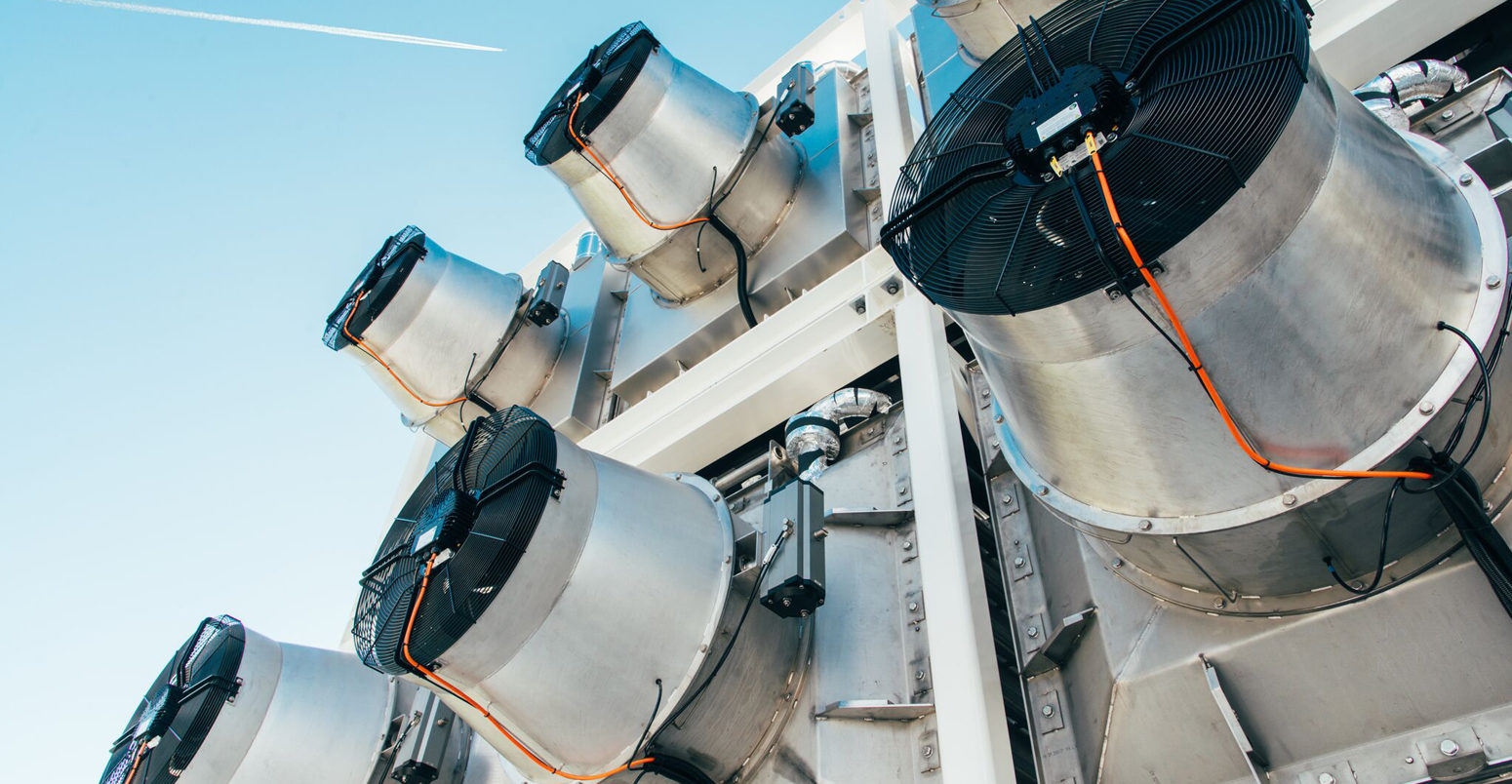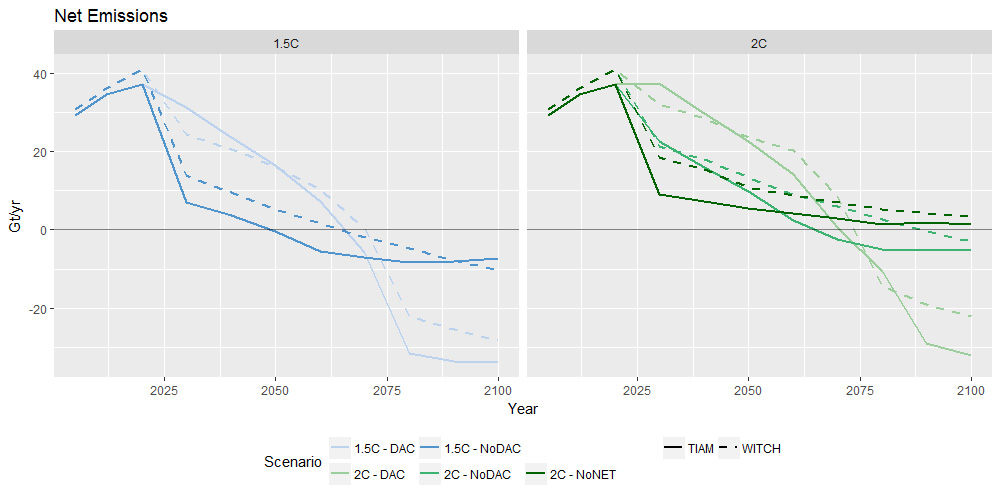
Direct CO2 capture machines could use ‘a quarter of global energy’ in 2100
Simon Evans
07.22.19Simon Evans
22.07.2019 | 10:00amMachines that suck CO2 directly from the air could cut the cost of meeting global climate goals, a new study finds, but they would need as much as a quarter of global energy supplies in 2100.
The research, published today in Nature Communications, is the first to explore the use of direct air capture (DAC) in multiple computer models. It shows that a “massive” and energy-intensive rollout of the technology could cut the cost of limiting warming to 1.5 or 2C above pre-industrial levels.
But the study also highlights the “clear risks” of assuming that DAC will be available at scale, with global temperature goals being breached by up to 0.8C if the technology then fails to deliver.
This means policymakers should not see DAC as a “panacea” that can replace immediate efforts to cut emissions, one of the study authors tells Carbon Brief, adding: “The risks of that are too high.”
DAC should be seen as a “backstop for challenging abatement” where cutting emissions is too complex or too costly, says the chief executive of a startup developing the technology. He tells Carbon Brief that his firm nevertheless “continuously push back on the ‘magic bullet’ headlines”.
Negative emissions
The 2015 Paris Agreement set a goal of limiting human-caused warming to “well below” 2C and an ambition of staying below 1.5C. Meeting this ambition will require the use of “negative emissions technologies” to remove excess CO2 from the atmosphere, according to the Intergovernmental Panel on Climate Change (IPCC).
This catch-all term covers a wide range of approaches, including planting trees, restoring peatlands and other “natural climate solutions”. However, model pathways developed by researchers rely most heavily on bioenergy with carbon capture and storage (BECCS). This is where biomass, such as wood pellets, is burned to generate electricity and the resulting CO2 is captured and stored.
The significant potential role for BECCS raises a number of concerns, with land areas up to five times the size of India devoted to growing the biomass needed in some model pathways.
One alternative is direct air capture, where machines are used to suck CO2 out of the atmosphere. If the CO2 is then buried underground, the process is sometimes referred to as direct air carbon capture and storage (DACCS).
Today’s new study explores how DAC could help meet global climate goals with “lower costs”, using two different integrated assessment models (IAMs). Study author Dr Ajay Gambhir, senior research fellow at the Grantham Institute for Climate Change at Imperial College London, explains to Carbon Brief:
“This is the first inter-model comparison…[and] has the most detailed representation of DAC so far used in IAMs. It includes two DAC technologies, with different energy inputs and cost assumptions, and a range of energy inputs including waste heat. The study uses an extensive sensitivity analysis [to test the impact of varying our assumptions]. It also includes initial analysis of the broader impacts of DAC technology development, in terms of material, land and water use.”
The two DAC technologies included in the study are based on different ways to adsorb CO2 from the air, which are being developed by a number of startup companies around the world.
One, typically used in larger industrial-scale facilities such as those being piloted by Canadian firm Carbon Engineering, uses a solution of hydroxide to capture CO2. This mixture must then be heated to high temperatures to release the CO2 so it can be stored and the hydroxide reused. The process uses existing technology and is currently thought to have the lower cost of the two alternatives.
The second technology uses amine adsorbents in small, modular reactors such as those being developed by Swiss firm Climeworks. Costs are currently higher, but the potential for savings is thought to be greater, the paper suggests. This is due to the modular design that could be made on an industrial production line, along with lower temperatures needed to release CO2 for storage, meaning waste heat could be used.
Delayed cuts
Overall, despite “huge uncertainty” around the cost of DAC, the study suggests its use could allow early cuts in global greenhouse gas emissions to be somewhat delayed, “significantly reduc[ing] climate policy costs” to meet stringent temperature limits.
Using DAC means that global emissions in 2030 could remain at higher levels, the study says, with much larger use of negative emissions later in the century. This is shown in the charts, below, for scenarios staying below 1.5C (left panel, shades of blue) and 2C (right, green).
Pathways without DAC are shown in darker shades. For example, the solid dark blue line shows results from the “TIAM” model, with emissions peaking around 2020 and falling rapidly to below zero around 2050.
In contrast, the light blue solid line shows a pathway where DAC allows a more gradual decline, reaching zero in the 2060s and with negative emissions of around 30 billion tonnes per year (Gt/yr) by the 2080s. This is close to today’s annual global emissions of around 40GtCO2/yr.

Global CO2 emissions from fossil fuels (Gt/yr) in model pathways consistent with limiting warming this century to 1.5C (left panel, blue) or 2C (right panel, green). Results from two different IAMs – TIAM and WITCH – are shown with solid and dashed lines, respectively. The various lines show scenarios that use direct capture (“DAC”, darker shades) and those that do not (“NoDAC”, lighter), as well as pathways to 2C without negative emissions of any sort (“NoNET”, darkest green). Source: Realmonte et al. (2019).
“The results of both models are surprisingly similar,” says Dr Nico Bauer, a scientist at the Potsdam Institute for Climate Impacts Research (PIK), who was not involved in the study. He tells Carbon Brief: “This increases the credibility about the main conclusions that the DACCS technology can play an important role in a long-term climate change mitigation strategy.”
The use of DAC in some of the modelled pathways delays the need to cut emissions in certain areas. The paper explains: “DACCS allows a reduction in near term mitigation effort in some energy-intensive sectors that are difficult to decarbonise, such as transport and industry.”
Steve Oldham, chief executive of DAC startup Carbon Engineering says he sees this as the key purpose of CO2 removal technologies, which he likens to other “essential infrastructure” such as waste disposal or sewage treatment.
Oldham tells Carbon Brief that while standard approaches to cutting CO2 remain essential for the majority of global emissions, the challenge and cost may prove too great in some sectors. He says:
“DAC and other negative emissions technologies are the right solution once the cost and feasibility becomes too great…I see us as the backstop for challenging abatement.”
Comparing costs
Even though DAC may be relatively expensive, the model pathways in today’s study still see it as much cheaper than cutting emissions from these hard-to tackle sectors. This means the models deploy large amounts of DAC, even if its costs are at the high end of current estimates.
It also means the models see pathways to meeting climate goals that include DAC as having lower costs overall (“reduce[d]… by between 60 to more than 90%”). Gambhir tells Carbon Brief:
“Deploying DAC means less of a steep mitigation pathway in the near-term, and lowers policy costs, according to the modelled scenarios we use in this study.”
However, the paper also points to the significant challenges associated with such a large-scale, rapid deployment of DAC, in terms of energy use and the need for raw materials.
The energy needed to run direct air capture machines in 2100 is up to 300 exajoules each year, according to the paper. This is more than half of overall global demand today, from all sources, and despite rising demand this century, it would still be a quarter of expected demand in 2100.
To put it another way, it would be equivalent to the current annual energy demand of China, the US, the EU and Japan combined – or the global supply of energy from coal and gas in 2018.
Gambhir tells Carbon Brief:
“Large-scale deployment of DAC in below-2C scenarios will require a lot of heat and electricity and a major manufacturing effort for production of CO2 sorbent. Although DAC will use less resources such as water and land than other NETs [such as BECCS], a proper full life-cycle assessment needs to be carried out to understand all resource implications.”
Deployment risk
There are also questions as to whether this new technology could be rolled out at the speed and scale envisaged, with expansion at up to 30% each year and deployment reaching 30GtCO2/yr towards the end of the century. This is a “huge pace and scale”, Gambhir says, with the rate of deployment being a “key sensitivity” in the study results.
Prof Jennifer Wilcox, professor of chemical engineering at Worcester Polytechnic Institute, who was not involved with the research, says that this rate of scale-up warrants caution. She tells Carbon Brief:
“Is the rate of scale-up even feasible? Typical rules of thumb are increase by an order of magnitude per decade [growth of around 25-30% per year]. [Solar] PV scale-up was higher than this, but mostly due to government incentives…rather than technological advances.”
Reaching 30GtCO2/yr of CO2 capture – a similar scale to current global emissions – would mean building some 30,000 large-scale DAC factories, the paper says. For comparison, there are fewer than 10,000 coal-fired power stations in the world today.
If DAC were to be carried out using small modular systems, then as many as 30m might be needed by 2100, the paper says. It compares this number to the 73m light vehicles that are built each year.
The study argues that expanding DAC at such a rapid rate is comparable to the speed with which newer electricity generation technologies such as nuclear, wind and solar have been deployed.
The modelled rate of DAC growth is “breathtaking” but “not in contradiction with the historical experience”, Bauer says. This rapid scale-up is also far from the only barrier to DAC adoption.
The paper explains: “[P]olicy instruments and financial incentives supporting negative emission technologies are almost absent at the global scale, though essential to make NET deployment attractive.”
Carbon Engineering’s Oldham agrees that there is a need for policy to recognise negative emissions as unique and different from standard mitigation. But he tells Carbon Brief that he remains “very very confident” in his company’s ability to scale up rapidly.
(Today’s study includes consideration of the space available to store CO2 underground, finding this not to be a limiting factor for DAC deployment.)
Breaching limits
The paper says that the challenges to scale-up and deployment on a huge scale bring significant risks, if DAC does not deliver as anticipated in the models. Committing to ramping up DAC rather than cutting emissions could mean locking the energy system into fossil fuels, the authors warn.
This could risk breaching the Paris temperature limits, the study explains:
“The risk of assuming that DACCS can be deployed at scale, and finding it to be subsequently unavailable, leads to a global temperature overshoot of up to 0.8C.”
Gambhir says the risks of such an approach are “too high”:
“Inappropriate interpretations [of our findings] would be that DAC is a panacea and that we should ease near-term mitigation efforts because we can use it later in the century.”
Bauer agrees:
“Policymakers should not make the mistake to believe that carbon removals could ever neutralise all future emissions that could be produced from fossil fuels that are still underground. Even under pessimistic assumptions about fossil fuel availability, carbon removal cannot and will not fix the problem. There is simply too much low-cost fossil carbon that we could burn.”
Nonetheless, Prof Massimo Tavoni, one of the paper’s authors and the director of the European Institute on Economics and the Environment (EIEE), tells Carbon Brief that “it is still important to show the potential of DAC – which the models certainly highlight – but also the many challenges of deploying at the scale required”.
The global carbon cycle poses one final – and underappreciated – challenge to the large-scale use of negative emissions technologies such as DAC: ocean rebound. This is because the amount of CO2 in the world’s oceans and atmosphere is in a dynamic and constantly shifting equilibrium.
This equilibrium means that, at present, oceans absorb a significant proportion of human-caused CO2 emissions each year, reducing the amount staying in the atmosphere. If DAC is used to turn global emissions net-negative, as in today’s study, then that equilibrium will also go into reverse.
As a result, the paper says as much as a fifth of the CO2 removed using DAC or other negative emissions technologies could be offset by the oceans releasing CO2 back into the atmosphere, reducing their supposed efficacy.
Realmonte, G. et al. (2019) An inter-model assessment of the role of direct air capture in deep mitigation pathways, Nature Communications, http://dx.doi.org/10.1038/s41467-019-10842-5
-
Direct CO2 capture machines could use ‘a quarter of global energy’ in 2100


